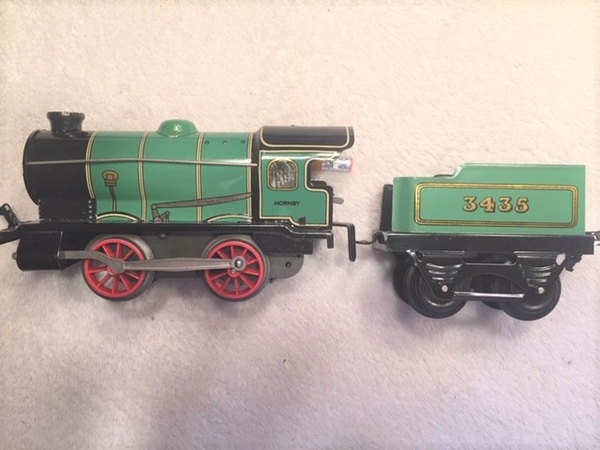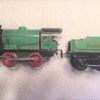jhz53: As Fatman showed you, you have a No.20 loco and wagon. These were made from 1954 - 1968 (about the end of production in Gauge O). The key thing about the logo on the tender is that it was the first recognition by Hornby of railway nationalization in the UK which had actually taken place in 1948. The MO locomotives represent perhaps the largest production in Gauge O and were sort of the base sets available (a bit like Lionel 0-27). In the Postwar era they became more toy like and were pointed at the "playroom" than than at the serious modeler. The No 20 is a member of the MO "class" and was the first Hornby Gauge O trains to appear in the British Railways livery . The MO Goods set (freight) and Passenger Sets were revised in 1954 and became known as the Goods Train Set No 20 and Passenger Train Set No.21. The No 20 loco and tender were in a dark green livery, lined in orange and black with a cabside number in British Railways style. The logo you like so much on the tender is known as "The Lion and Wheel" emblem and was the first representation of BR. The No 20 wagon that appeared in your first picture, is the same wagon as the MO wagons BUT instead of being decorated in the livery of individual railways came in BR standard grey without any specific lettering. Why did it take from 1948 to 1954 for Hornby to recognize railway nationalization...who knows? There were always shortages of materials and production in the postwar years and they could hardly keep up with demand so there was little incentive for a substantial change in the product line especially at the "low" end where it was likely that their patrons (primarily children) would care that much.
By the way, as an interesting sidelight you are seeing the near end of Gauge O production. Hornby had discovered a very strong market interest and sales in their "Dublo sets" Gauge OO or near HO . In fact they had determined that the market was so strong for these smaller sets that even though a Dublo set cost about 1/2 the price to make in production as compared with O they could sell it for 2X what they traditionally sold the Gauge O sets. In addition, given the continual shortage of materials in the postwar era, they could make nearly twice as many trains with the same amount of material.
I have a M1 Goods Set from 1948 (according to the dated inspection slip still in the box) and it is in the pre-nationalization livery. The construction of the engine and most of the litho is identical to your No. 20 except it carries "Hornby" in black letters under the cab windows and the engine number vice the "Lion and Wheel" on the tender. My wagons are identical to yours in construction but the livery is again the pre-nationalization railway names. Here are some pictures:
Great stuff guys and it was really interesting trying to research the data. Note: For your interest, most of the data that I found was contained in..."The Hornby Companion Series, The Hornby Gauge O System by Chris and Julie Graebe", New Cavendish Books, 23 Craven Hill, London W2 3EN, 1985. This is a really neat book however it is about 75% - 25% devoted to the pre war era and it does have a higher concentration on the more expensive lines.
Best regards everyone
Don McErlean
.






